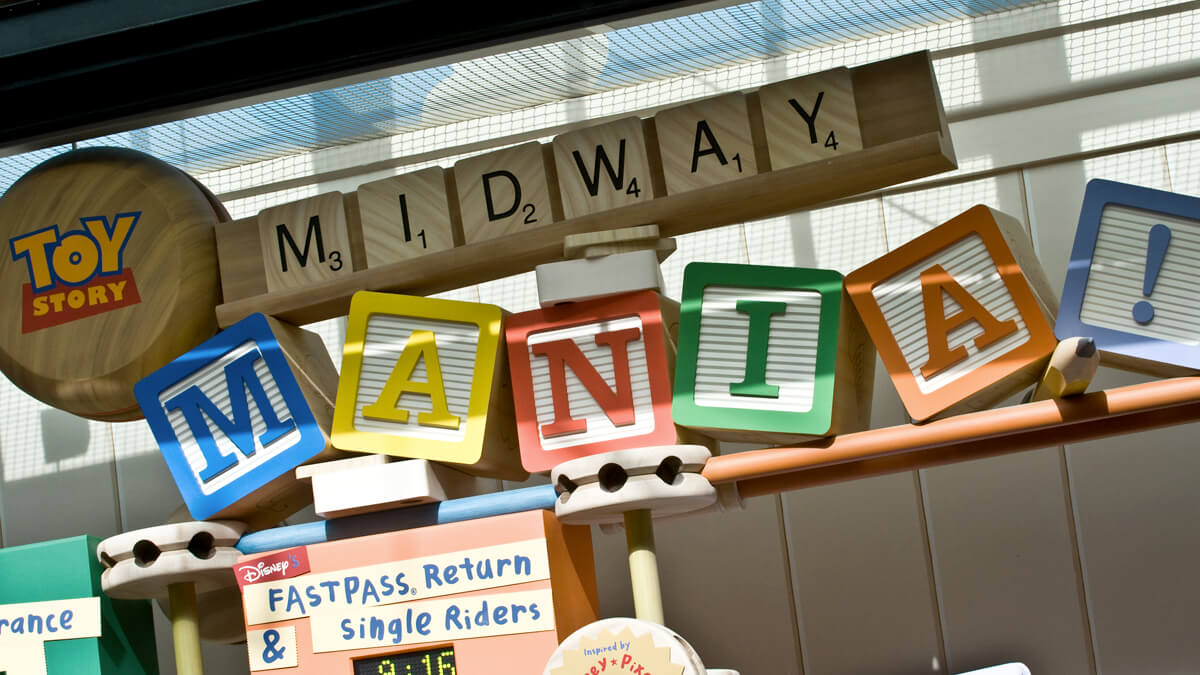
DisneyQuest
Toy Story Midway Mania starts in Orlando. To be specific, on the West Side of Downtown Disney. Which is where the first DisneyQuest opens on June 19, 1998.
For those of you who never got to experience a DisneyQuest, this was an indoor interactive theme park. 5 stories tall with a 100,000 square feet of space inside. Disney’s Regional Entertainment division built the first one in Orlando so that they could fine tune this concept before the Company went worldwide with DisneyQuest. At one point, there was a plan to build 30 of these indoor interactive theme parks around the globe.
Managed to cram a surprising variety of rides, shows & attractions into this 5 story-tall structure. There were things like:
The Virtual Jungle Cruise
Where Guests would climb into a real inflatable raft (which was on a motion base) and then — using a real paddle — they would face a screen where footage of a CG version of a prehistoric river would be projected on.
The storyline here keyed off of Disney’s “Honey, I Shrunk the Kids” movies. Wayne Szalinski has invented a time machine. But he gets swept away in the current. And the only way we get to return to the present is if we now head downriver & rescue Wayne while avoiding any dinosaurs we encounter en route.
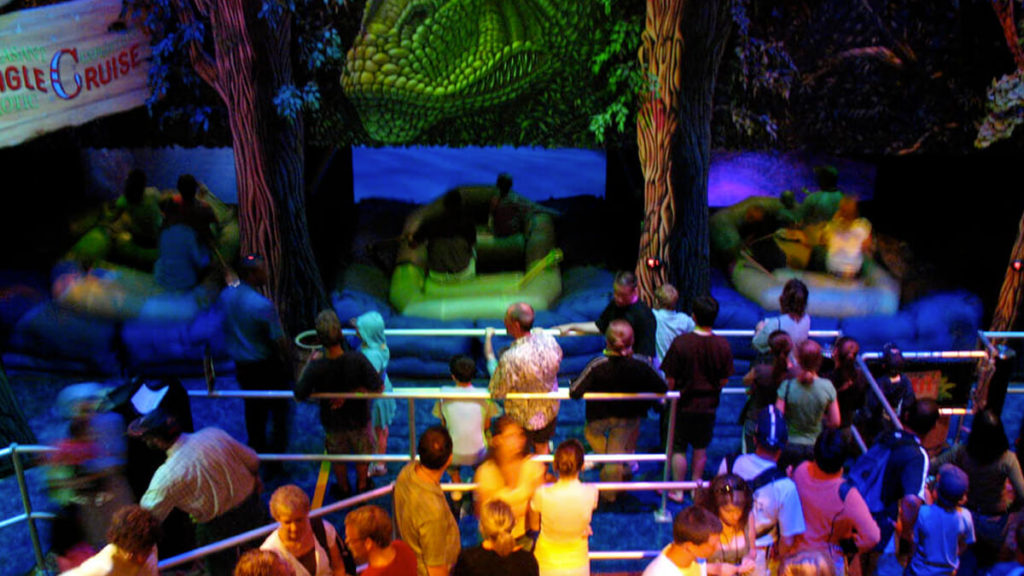
CyberSpace Mountain
As they waited to board this two person, pitch-and-roll simulator, Guests could actually design the roller coaster that they wanted to experience. Bill Nye the Science Guy — who was starring in a Disney-produced television series back in the mid-to-late 1990s — served as the host of this attraction.
Aladdin’s Magic Carpet Ride
Guest would first take a seat of a motion-based rig. They’d then get a helmet with a head-mounted display placed on the front of their face. They’d then take off on a magic carpet ride through Agrabah, the mythical Middle Eastern Kingdom seen in Disney’s 1992 hit, “Aladdin.” Your mission — as you zoomed along narrow streets and/or flew past minarets — was to collect enough gems to that you could then rescue the Genie. Who was once again trapped in the Cave of Wonders.
You get the idea, right? Disney stories, characters & attractions that the Guests already love but now powered by cutting edge tech.
And the beauty part was — as part of its ambitious DisneyQuest initiative — the Company’s Regional Entertainment division actually embraced a video arcade aesthetic. Meaning that they knew going in that — in order to keep Guests coming back — the assortment of rides, shows & attractions that DisneyQuest offered would have to be dynamic. There’d have to be something new of size for people to see and/or experience the next time they visit this indoor theme park.
This is why — even though “Hercules in the Underworld” had been an opening day attraction at the Orlando version of DisneyQuest, just two years after this interactive game came online along with the rest of the Downtown Disney version of DisneyQuest, “Hercules in the Underworld” was shuttered to make way for an brand-new interactive experience. And that was “Pirates of the Caribbean: Battle for Buccaneer Gold.”
Pirates of the Caribbean: Battle for Buccaneer Gold
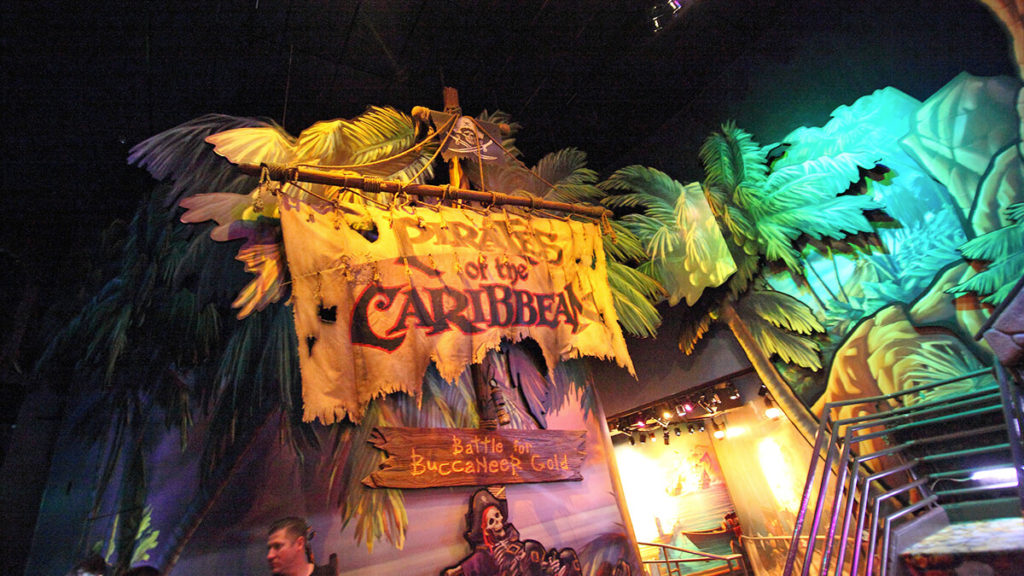
This 5 minute-long experience was really the gold standard for interactive technology back in 2000 . Five Guests at a time entered this space where they were enveloped by this 270 degree screen. There were five different stations , four where Guests stood behind cannons with pull string mechanisms and then a centrally located ship’s wheel (This is where the captain stood). And once everyone was issued a pair of 3D glasses, the adventure began.
Your goal here was to sail your pirate ship out into the harbor and then — by using your on-board cannon to barrage the other vessels & sea creatures you encountered — collect as much pirate booty & ammunition as you could. Which your pirate ship would then need as you moved into the final phase of this ride experience. Where you then did battle with Jolly Roger and his ship full of ghostly skeletons.
Now what was truly cool about “Pirates of the Caribbean: Battle for Buccaneer Gold” was that all five players stood on a motion-based platform that then moved in response to whichever way the captain turned the ship’s wheel. So if he or she suddenly turned your pirate ship starboard, the Guests manning the cannons would suddenly find themselves leaning to the right. The same thing happened when the Captain course corrected to the left. The cannon crew suddenly found themselves swaying to the port side.
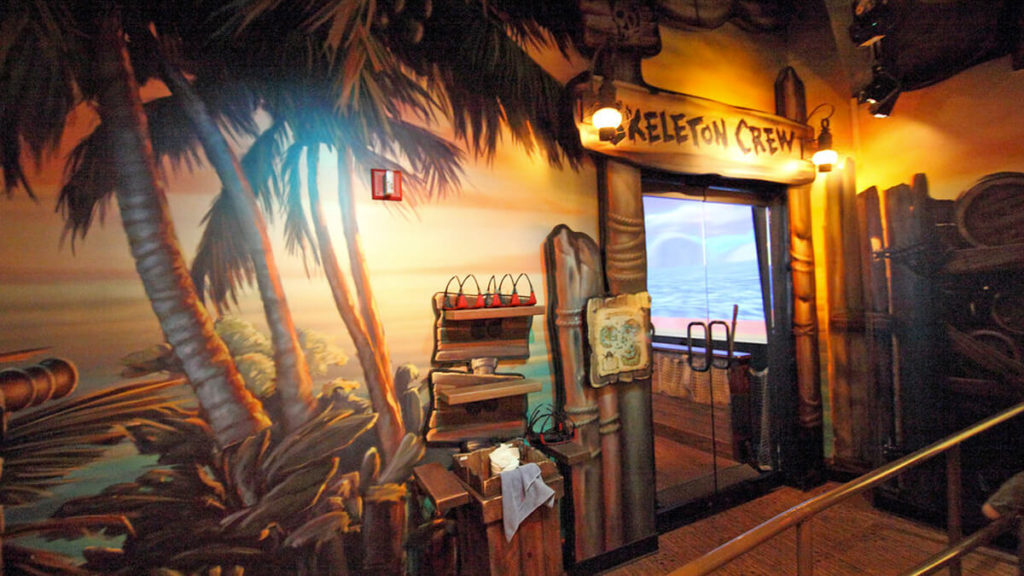
Better yet, the images that were projected on that 270 degree screen synced up in real time with the way the captain spun the ship’s wheel. And if all of those cannonballs you fired at another ship were to then cause that pirate ship’s armory to explode … Well, on “Pirates of the Caribbean: Battle for Buccaneers Gold,” you’d not only hear that explosion in high fidelity surround sound, you’d also briefly feel the heat of the flames. Not to mention get a quick whiff of smoke from that fire.
This was truly cutting-edge tech for the time. And other people working in themed entertainment back in the early 2000s recognized that. Which is why — at the 8 th annual THEA Awards (THEA stands for the Themed Entertainment Association) — “Pirates of the Caribbean: Battle for Buccaneer Gold” was recognized by WDI’s peers / given an award for outstanding achievement.
The irony here is — while “Pirates of the Caribbean: Battle for Buccaneer Gold” is being singled out for praise by themed entertainment professionals — by 2001, DisneyQuest itself (as a chain of indoor theme parks, I mean) is circling the bowl.
Death of DisneyQuest
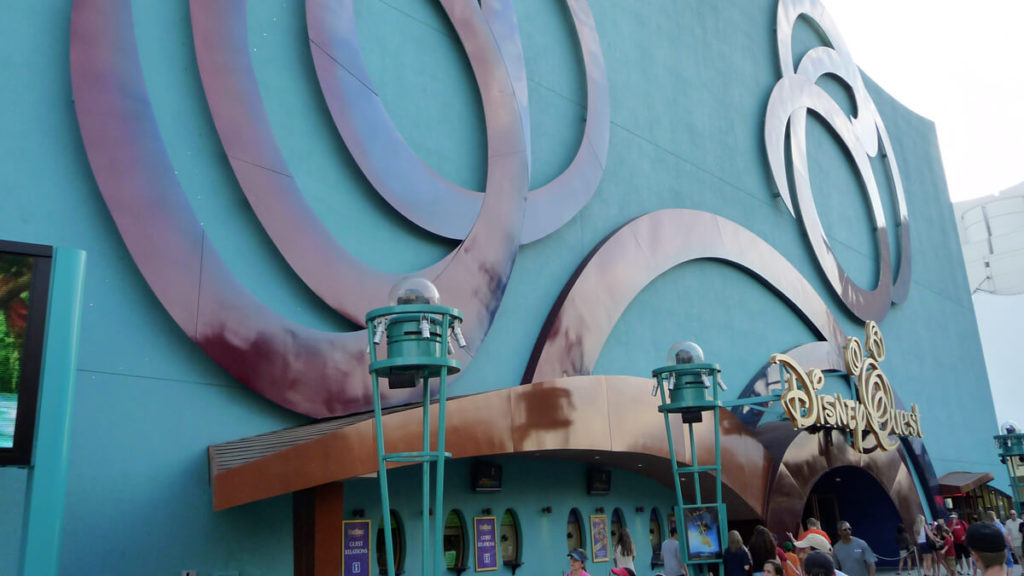
A 90,000 square foot version of DisneyQuest opened in Chicago on June 16, 1999 . It shuttered on September 4, 2001 after being open for business for just two years & three months. Did well on weekends. Stood empty most weekdays.
Disney Regional Entertainment broke ground on an 80,000 square foot version of DisneyQuest in Philadelphia in February of 1999 . But after a cellar hole is dug for this five story structure was dug in the Spring of that same year , work slows down on site as Disney Corporate begins to lose confidence in its indoor theme park concept. Philly locals begin to refer to the now-abandoned worksite as the Disney Hole.
It isn’t ‘til July of 2001 that The Walt Disney Company officially pulls the plug on DisneyQuest (Though the Orlando version of this indoor theme park would stay in business for another 16 years . This West Side fixture would remain open ‘til July 2, 2017 . Whereupon this 100,000 square foot structure was gutted to make way for the NBA Experience. Which somehow managed to be even less successful / popular than DisneyQuest was).
Why did the Downtown Disney version of DisneyQuest stay opened?
The Downtown Disney version of DisneyQuest stayed operational for over 19 years for two reasons:
- There was enough rainy days in Orlando where Guests — after they’d been chased out of the Disney Parks by showers — needed someplace to go that the Downtown Disney version of DisneyQuest did steady if less-than-spectacular business.
- The Company never invested another dime in developing new attractions for DisneyQuest after “Pirates of the Caribbean: Battle for Buccaneer Gold” was installed.
Problems at the Walt Disney Company in 2001
Now you have to remember that 2001 was a year when The Walt Disney Company was dealing with a lot of problems. Especially when it came to the theme park & resorts side of things. In February of that same year , Disney’s California Adventure opened at the Disneyland Resort and almost immediately underwhelmed theme park fans. Then seven months after that came 9/11 … And — for at least six months or so — attendance levels at Disney Parks worldwide plummeted because people were afraid to get on airplanes for a while there.
The pressure was on do something — anything, really — to turn DCA around. The initial perception of that theme park is that it lacked kid appeal. Which is why “A Bug’s Land” got fast-tracked. That one-and-a-third-acre “land” opened for business on October 7, 2002 .
Which helped. A little. However, over the Paradise Pier portion of this theme park, with the exception of King Triton’s Carousel of the Sea … Well, that side of DCA had no characters. And relatively low overall hourly ride capacity.
Idea for a Dark Ride in California Adventure

The thinking was that this side of California Adventure needed a dark ride. Something built around a popular Disney character to draw people to this side of that theme park.
Now the problem with DCA — at least at this point — was that The Walt Disney Company had initially spent $1.1 billion on the expansion of the Disneyland Resort. And for that amount of money, they’d gotten:
- The Grand Californian Resort & Spa
- The Disneyland Esplanade
- The Downtown Disney shopping & dining district
- The Mickey & Friends Parking Structure (with spots for 10,000 cars)
And all of that stuff was working just the way it was supposed. That portion of the Disneyland Resort expansion plan was working great. It was only DCA itself that was proving to be a disappointment.
Given the $1.1 billion that the Company had already outlaid (And given the sudden shrink in theme park revenue that came on the heels of 9/11) — Mouse House managers initially held on real tight to those purse strings and only begrudgingly released funds to try & fix California Adventure.
Which is when the Imagineers — as they were putting together proposals for a dark ride to possible add to Paradise Pier’s meager assortment of rides, shows & attractions — went into this project looking for ways to economize. Creative short cuts that would then allow them to deliver a popular character-based ride at a bargain basement development cost.
It was about this time at someone at WDI brought up the cannons that were used in “Pirates of the Caribbean: Battle for Buccaneer Gold.” Seaside amusement parks always had shooting galleries. What if they were to take those cannons with their pull string firing mechanism and somehow attached those to a ride vehicle that passed through a space filled with targets?
The folks at the Disneyland Resort said … Well, yeah. That does sounds like fun. But aren’t we already building a ride like that over in Tomorrowland? The “Buzz Lightyear Astro Blasters” attraction? Which is supposed to open in March of 2005 and then be one of the spotlighted aspects of Disneyland Park’s 50 th anniversary celebration .
The Imagineers response was “Well, the ride-thru shooting gallery we have in the work for DCA’s Paradise Pier area will be different.
- It won’t be a clone of a pre-existing Disney World attraction (“Buzz Lightyear’s Space Ranger Spin” opened at WDW’s Magic Kingdom some 7 years earlier. November of 1998 , to be exact).
- Our ride-thru shooting gallery won’t have ray guns with triggers. Ours will be completely different. We’ll have cannons with pull strings. CANNONS .
- More importantly, our ride will be built around the Company’s biggest star: Mickey Mouse.
Mickey Mouse Themed Attraction in Disneyland

The Imagineers — as they were getting ready to enhance Paradise Pier (now Pixar Pier) back in October of 2007, they were looking to add a ride-thru shooting gallery to that portion of Disney California Adventure that would have been built around Mickey Mouse.
You have to remember that — since Disneyland first opened back in July of 1955 — the general public have been clamoring for some sort of ride, show & attraction built around Mickey Mouse.
Where’s Mickey? – Disneyland’s Introduction to Mickey Mouse Walk-around Character
Well, if we’re being completely honest here, it wasn’t until the Fall of that same year that Disneyland began to have a Mickey Mouse problem. Starting on October 3, 1955, “The Mickey Mouse Club” began airing on ABC five days a week, Monday through Friday. This was initially a hour-long program (“The Mickey Mouse Club” wasn’t cut back ‘til the half hour-long length we know today ‘til the start of its third season on ABC. Which began on September 30, 1957).
By the Fall of 1955, Guests were arriving at Disneyland Park and asking the Cast Members who worked there “Where’s Mickey?” And you have to understand that — back then — Disneyland didn’t have a Mickey Mouse costume to put a Cast Member in. In that “Dateline Disneyland’ special that aired on ABC back in July of that same year (You know? That 90 minute-long TV special which showed Mickey, Minnie & the gang parading down Main Street, U.S.A. as part of that live broadcast?), the costumes that had appeared on camera had been borrowed from Ice Capades. Which was this touring ice skating show produced by John H. Harris.
Disney Themed Ice Capades
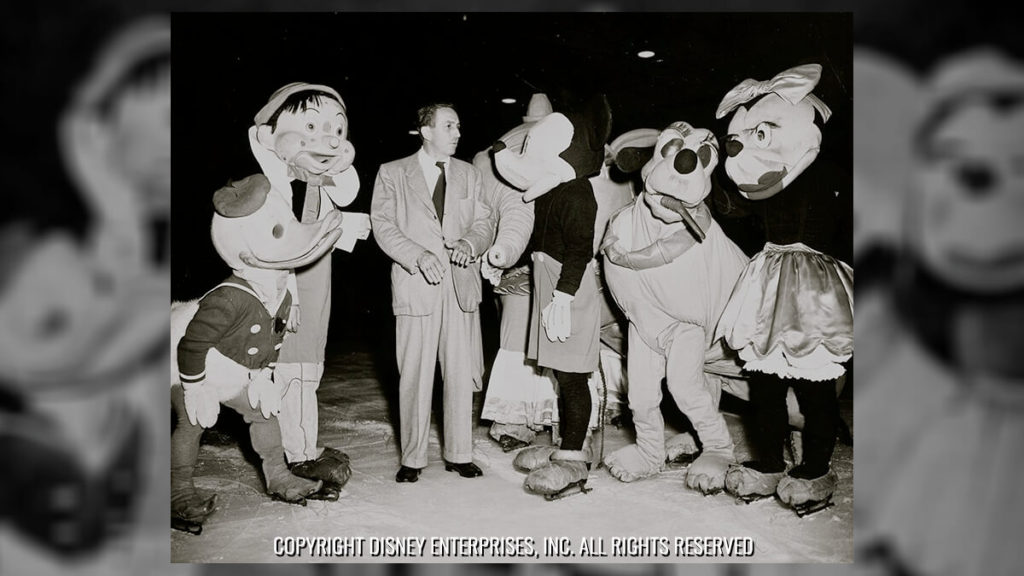
Back in 1949, the Ice Capades had entered into a multi-year agreement with Walt Disney Productions. The idea here was — with each new production of the Ice Capades (Harris sent a new version of this touring ice show out on the road annually) — there’d be a lengthy segment in each new show that was Disney themed.
This started out in the 1950 edition of Ice Capades. Which included a “Walt Disney Toy Shop” sequence. Where performers dressed as Mickey, Minnie, Donald, Pinocchio, Dumbo & Pluto (Those last two characters were turned into two person costumes. With one skater up front manipulating the front legs of this suit and another skater to the back moving the back legs of this character costume) would perform as part of that year’s show.
This idea began to evolve with each new edition of the Ice Capades. By the Ice Capades of 1952, this 20 minute-long Disney-themed segment now celebrated a single film. In this case, it was “Cinderella,” which had been released to theaters in March of 1950.
Getting back to Disneyland’s Mickey Mouse problem now. Walt had been able to call John H. Harris back in the Summer of 1955 and borrow all of Ice Capades Disney character costumes for that live TV special which would air on ABC. But by the Fall of that same year, this just wasn’t an option anymore. That year’s edition of the Ice Capades was back on the road at that point. And that touring ice show needed all of these Disney character costumes for its nightly performances.
Disneyland’s Tom Sawyer Island or Mickey & Minnie Mouse Island

Money was still tight at this time (Remember that — during the late Summer of 1955 — Southern California had experienced record high temperatures. And as a direct result, attendance levels at Disneyland Park in late August / early September had temporarily fallen through the floor). So Walt didn’t have a lot of available capital to work with when it came to appeasing all of those “Mickey Mouse Club” fans who were showing up in Anaheim and then demanding an audience with Mickey.
One idea that was floated at that time was to take the then-still-under-construction Tom Sawyer Island (which wouldn’t open to the public ‘til June 16, 1956) into Mickey & Minnie Mouse Island.
This idea actually dated back to the April 1954 description of Disneyland Park that Nat Winecoff (who was the original General Manager & Vice President of Disneyland, Inc) … Anyway, at Walt’s insistence, Nate wrote this 12-page document which went land by land through this yet-to-be-built family fun park.
The following description can be found on Page 11 of “The Disneyland Story.” And what I’m reading here is a direct quote from what Mr. Winecoff wrote back on April 20, 1954.
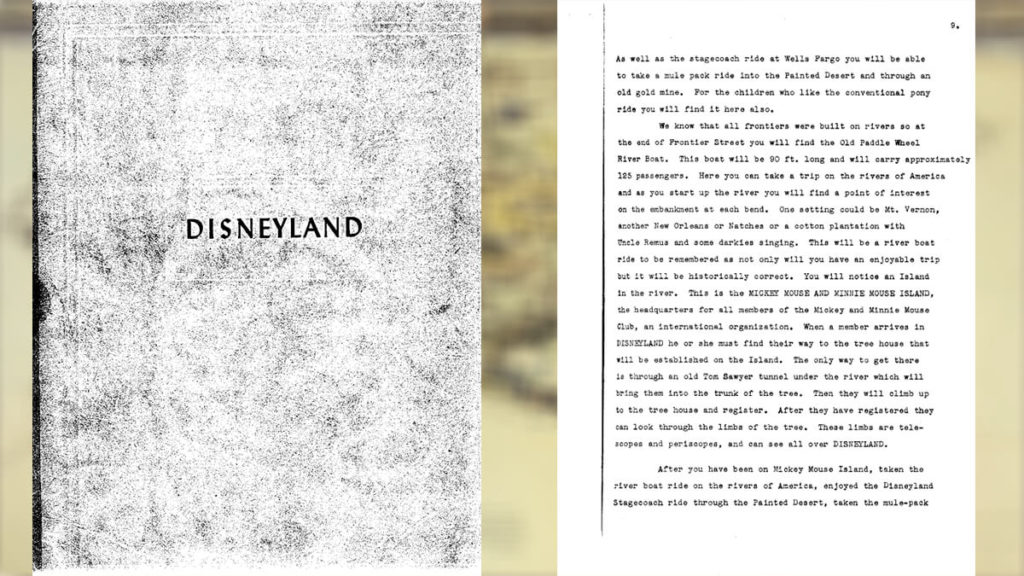
… Old Paddle Wheel River Boat. This boat will be 90 feet long and will carry approximately 125 passengers. Here you can take a trip on the Rivers of America. And as you start up the river, you will see a point of interest on the embankment of each bend. One setting could be Mount Vernon, another New Orleans or Natches or a cotton plantation with Uncle Remus…singing.
This will be a river boat ride to be remembered as not only will you have an enjoyable trip but it will also be historically correct.
You will notice an island in the river. This will be the Mickey Mouse and Minnie Mouse Island, the headquarters for all members of the Mickey and Minnie Mouse Club, an international organization.
When a member arrives at Disneyland, they must find their way to the tree house that will be established on the island. The only way to get there is through an old Tom Sawyer tunnel under the river which will bring them into the trunk of the tree. After they have registered, they can then look through the limbs of the tree. These limbs are telescopes & periscopes and can see all over Disneyland.
Nat Winecoff – The Disneyland Story
Just want to stress here that it was Nat Winecoff who wrote this description. Not Walt. And Nat died ‘way back in January of 1983. So — at this point — it’s hard to get any additional info about that “ … a cotton plantation with Uncle Remus…singing” section of this description.
Also want to stress here that the plans of Disneyland were very dynamic back in 1954. How do I know this? Well, let me now share a similar section from the official Disneyland Prospectus. Which also features a description of the Old Paddle Wheel River Boat ride.
Mind you, this version of a description of that Frontierland attraction was written on September 3, 1954. Some four and a half months after the version that Nate Winecoff wrote. Listen carefully for the key differences.
At the end of Frontier Land, you will find Paul Bunyan’s longest little bar with the tallest glass of root beer. At this point, you can walk over to the Pier and get on the 105 foot Paddle Wheel River Boat, which can carry approximately 300 passengers. This will be a trip that will be well remembered, as you will be taking a ride on the Rivers of America. You will be able to identify the river you are on by the historical point of interest which will be on the embankment, in scale. As you leave FrontierLand, you may see Mount Vernon on the first bend of the river. The next one could be New Orleans, Natchez, Mobile, or any other place of interest that is well known as a historical river landmark.
Nate Winecoff – official Disneyland Prospectus
In four & a half months’ time, the length of the Mark Twain riverboat was changed from 90 feet to 105 feet. This Frontierland attraction’s ride capacity jumped from 125 passengers per trip to 300 passengers per trip. And all mention of seeing a cotton plantation along the banks of the Rivers of America from which Uncle Remus could be heard singing.
You’ll also note that any mention of Mickey & Minnie Mouse Island was also removed. I’m told that this idea stayed on the books ‘til the Fall of 1955. At that point, after a few months of operating Disneyland Park, Walt realized …
Well, in order to build that secret Tom Sawyer tunnel under the Rivers of America which would then allow Mickey Mouse Club members to secretly enter that tree house … Construction of that admittedly cool sounding feature would have then involved first draining the Rivers of America, then digging the actual tunnel under the riverbed, and finally doing weeks of tests to guarantee that this new underground passageway over to Mickey & Minnie Mouse Island had a water-tight seal.
And at a time where Disneyland Park was struggling with its hourly ride capacity, taking the Mark Twain Riverboat offline for months at a time (Back in 1955 — had the second highest ride capacity at Disneyland Park, 1500 Guests per hour) wasn’t an option.
Paul Bunyan and Land of Legend at Disneyland
Me personally, I wish that they’d gone ahead with the construction of Paul Bunyan’s longest little bar. But in a way, they did. How many of you remember the Mile Long Bar? There was one at Walt Disney World at the exit of “The Country Bear Jamboree” which operated from October of 1971 through January of 1998. And there was one at Disneyland Park, which operated in the Bear Country section of that theme park from March of 1972 through 2002 (That one got renamed the B’rer Bar in 1989).
The mirror illusion that made the Mile Long Bar work had originally been developed for Paul Bunyan’s biggest little bar back in 1954. Took two decades. But no good idea ever dies at WDI.

This area was to be known as the “Land of Legend.” Which was supposed to celebrate American folklore. Now I bring this up because … Well, one of the featured attractions of this new land at Disneyland Park was supposed to be the Paul Bunyan Buffeteria. With the idea here being that every meal that this restaurant served would have over-sized portions.
So the Paul Bunyan Buffeteria would serve up enormous orders of pancakes & omelettes that families could then spilt between them because the chefs there were used to cooking for Paul and didn’t know how to make anything small.
I bring up the oversized food thing because … Well, Pym’s Test Kitchen opened at the Avengers Campus in Anaheim. And the whole creative concept that drives this now hugely popular new Disney California Adventure eatery dates back to Paul Bunyan’s Buffeteria. Which — again — was supposed to be part of the “Land of Legends,” an expansion of Disneyland Park that was proposed back in 1973 that was supposed to celebrate American folklore.
No good idea ever really dies at WDI. It just sometimes takes decades for the right IP to appear.
But back in the Fall of 1955, Walt didn’t have decades to placate those rabid Mickey Mouse Club fans. They wanted face time with their favorite mouse right then & there.
So what did Walt do? And how does that eventually get us to Toy Story Midway Mania?
Mickey Mouse Character Costume
In the mid-to-late 1950s, Walt was trying to find a way to address the popularity of “The Mickey Mouse Club” TV show, especially at Disneyland Park. Turning Tom Sawyer Island at that theme park into the worldwide headquarters of that program was briefly considered. But since that project would have involved draining the Rivers of America for months at a time … That didn’t move forward.
Walt’s priorities then shifted to getting a walk-around character costume of Mickey built (since borrowing the one that Disneyland had previously used from the Ice Capades wasn’t really an option).
Getting a workable version of these walk-around character costumes took a number of years to get right. A lot of trial & error was involved. Finding that sweet spot where you had a costume that was a good likeness of that character while — at the same time — was comfortable for the Cast Member to wear / had good sightlines for safety was tough.
Walt assigned John Hench to this project. John, in turn, roped in Disney Studio Costume Department. Who were used to making things that would look good in front of a camera, rather than be practical for a teenager to wear as they worked a shift at a hot Southern Californian theme park.
As I said, the first set of costumes that John & the Disney Studio Costume Department produced for Disneyland Park were extraordinarily heavy and awkward. Take — for example — the earliest set of costumes that were created for the Three Little Pigs. They were made out of rebar and weighed more than 70 pounds each. The Cast Members who were playing the Pigs in the Park would develop severe back & neck aches after just a few minutes out onstage.
Walt quickly realized that John needed help on this project. So he roped in veteran Disney animator Bill Justice to bring some other ideas to the table when it came to character costumes for the Park.
Justice recalled — in his 1992 memoir, “Justice for Disney” — that …
“ … Walt once told me that ‘Other places can have thrill rides and bands and trains. But we have our characters.’ “
Disney went on to say …
“Bill, always remember we don’t want to torture the people who are wearing these character costumes. Keep in mind that the Cast Members inside of these things have to be as comfortable as possible. So always try to use the lightest weight materials when building these things and make sure that these character costumes have as much ventilation as possible.
With Walt, his first concern was always the safety & comfort of his Disneyland Cast Members. His second concern was the look of each individual costume. Making sure that the character likeness was as accurate as possible.”
It took nearly six years to get the balance of elements just right. But by the Summer of 1961, Disneyland Park finally had its very own dedicated set of 37 character costumes (They were three of each character created. With the idea that — while one was being cleaned and the other was in for repairs — there’d always be at least one version of that character costume available for a Cast Member to pull in. So that Disney character could then be out in the Park interacting with Guests and/or marching down Main Street, U.S.A. in one of Disneyland’s parades).
Walt had put so much time, effort & money into the creation of this set of character costumes for Disneyland at that point that he insisted that their arrival at his family fun park be promoted as if it were a brand-new ride, show or attraction. Which is why — during the Summer of 1961 — ads were purchased in all of the major Los Angeles newspapers & magazines which read:
We’re waiting to meet you at Disneyland
New fun in ’61. 37 of your favorite Disney characters in person. The Happiest Show on Earth has new nighttime adventures, too. Dancing every evening. “Fantasy in the Sky” fireworks nightly.
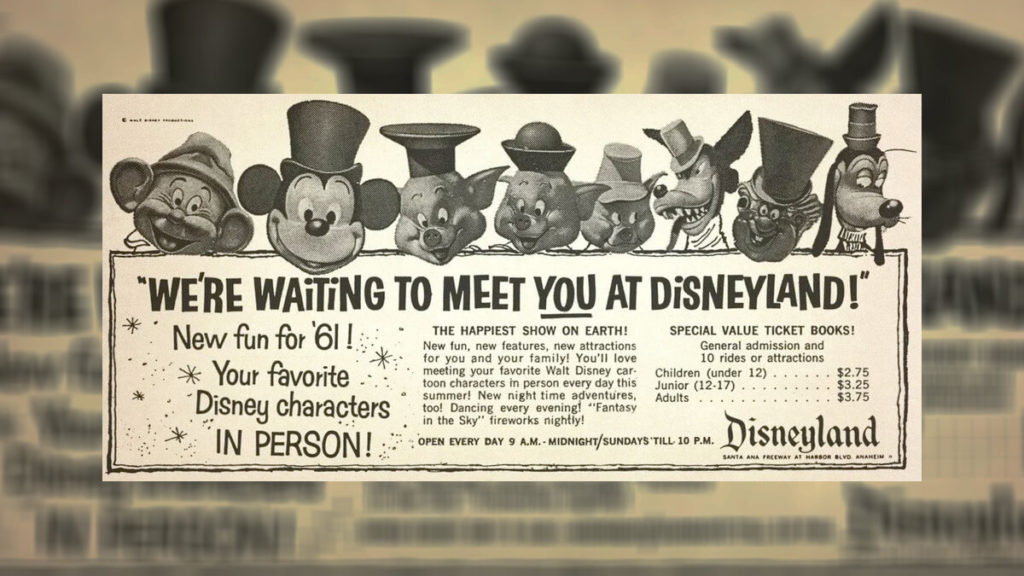
Why Doesn’t Mickey have his own ride at Disneyland?
While people were excited to now see Mickey daily at Disneyland Park in his walk-around character costume, what Walt now began to hear from Guests is:
Mr. Toad has his own ride. As does Dumbo. And Snow White. And Peter Pan. So why doesn’t Mickey have his own ride at Disneyland?
So Walt began to give this idea some thought. And — by September of 1962 — he did have a workable concept for a Mickey Mouse-themed attraction. Which he then told Canadian journalist Fletcher Markle about.
What Walt wanted to do was take the Mickey Mouse short, “Orphan’s Benefit” (The Studio had made a black & white version of this cartoon, which had been released to theaters in August of 1934. Seven years later, they revisited this story and created an all-new version of the “Orphan’s Benefit.” Only this time in color).
Orphan’s Benefit – Mickey Mouse Attraction
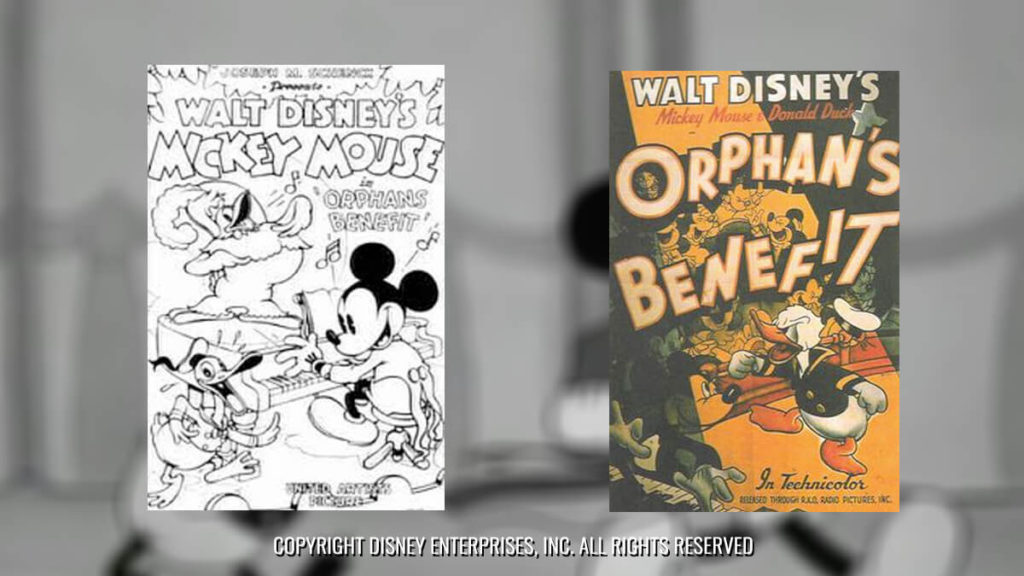
What Walt wanted to build at Disneyland Park was a cartoonish take on an old vaudeville house. Visitors to his family fun park would be seated in this theater’s orchestra section. While up in the mezzanine & balcony in that theater there were supposed to be all sort of Disney characters that we recognized from the Studio’s shorts, feature films & TV shows.
As the show got underway, animatronic versions of Mickey, Donald, Goofy, Clara Cluck & Horace Horsecollar would appear onstage and do brief musical numbers or perform magic tricks. And as each number ended, all of those cartoon characters up in the mezzanine & balcony would cheer, applaud or boo.
Sounds like a fun idea, right? The problem was … Audio-Animatronics was basically still in its infancy in the Fall of 1962. We were still nine months out from “The Enchanted Tiki Room” opening in June of 1963. And it’d be another 10 months after that before “Great Moments with Mr. Lincoln,” “Magic Skyway,” “it’s a small world” and “Progressland” would open at the 1964 – 1965 New York World Fair in April of that year.
And what Walt wanted to do with this “Orphan’s Benefit” -inspired show — with dozen of robotic Disney characters onstage performing tricks & songs, with a hundred or more other robotic characters up in the balcony and seated in the mezzanine responding to what was going on stage — this was WDI’s equivalent of sending a man to the moon. They’d have to make all sorts of technological breakthroughs before a theme park show like this was even possible.
And then Walt died in December of 1966. And the folks that were left behind — longtime Disney execs like Card Walker & Dick Irvine — they wanted to honor Walt’s legacy. Continue on with the ideas that he’d left behind. But — at the same time — Card & Dick had to be practical.
The Mickey Mouse Revue at Walt Disney World

So — as the “Orphan’s Benefit” show idea moved through WED’s development process — the idea of having the balcony & mezzanine levels of that old vaudeville theater filled with robotic Disney characters fell by the wayside. In its place rose “The Mickey Mouse Revue.” Which had Mickey as the maestro of this animatronic orchestra. One where King Louie from Disney’s “The Jungle Book” played tympany while the title character from Disney’s “Winnie-the-Pooh” played Kazoo.
And as all of these animatronic versions of well-known Disney characters played down in the pit, up onstage, the stars of some of the Studio’s better-known short subjects & feature films (i.e., “Snow White,” “Cinderella,” and “The Three Little Pigs”) appeared in brief musical numbers.
Mind you, this Audio Animatronic extravaganza was put into development at the same time as another ambitious theme park show. Which was “The Hall of Presidents.” But here’s the thing: When you’re putting together a show about a bunch of stuffy old white guys … Audio-Animatronics (especially the version of animatronics that Disney was using back in the late 1960s / early 1970s. Which was capable of very limited movement) was almost the perfect medium for “The Hall of Presidents.” Largely because stuffy old white guys are only capable of limited movement. Trust me, I know. Given that I myself am a stuffy old white guy …
Whereas if you’re looking to recreate cartoon characters who — in Disney’s feature films & shorts — can do squash & stretch, are capable of great feats of athleticism as they sing & dance … Audio-animatronics is the exact wrong medium.
This is why — when the Magic Kingdom at the WDW Resort opened in October of 1971 — “The Hall of Presidents” was immediately hailed as this technological marvel. Whereas “The Mickey Mouse Revue” was described as … Well, slight. Cute. A fun show you should catch once.
Which is why — less than 9 years into its run at the Fantasyland theater, “The Mickey Mouse Revue” closed on September 14, 1980. This animatronic show was then packed up & shipped off to Japan. Where it then became an opening day attraction at Tokyo Disneyland (which opened to the public in April of 1983).
Where’s the Mickey Ride?
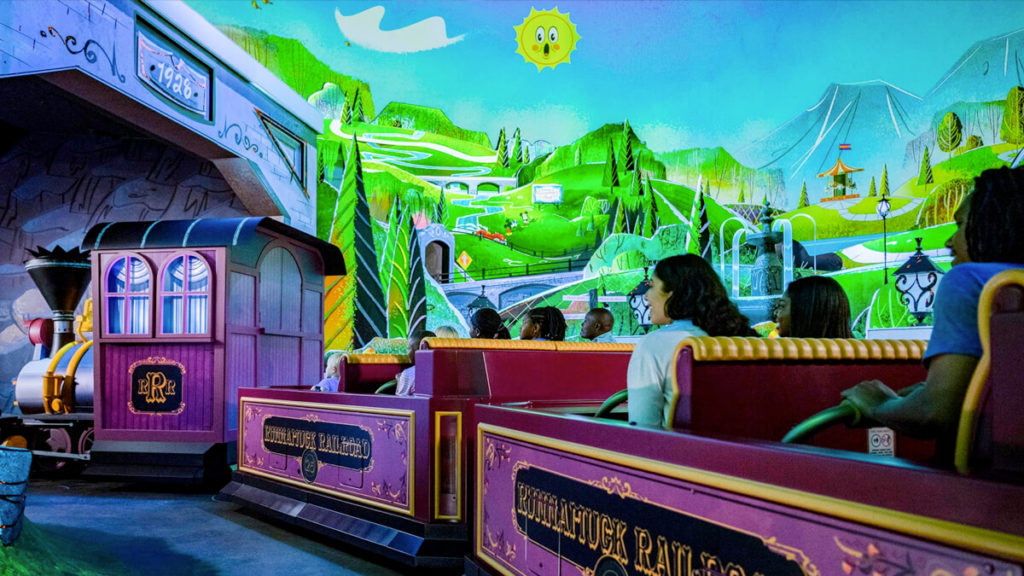
Mind you, this didn’t stop people who were going to the Disney theme park from asking “Where’s the Mickey ride?”
And — this time around — the Imagineers actually heard what the Guests were saying. They didn’t want a sit-down show for the Parks that featured Mickey Mouse. They wanted a ride.
So — for much of the 1970s & 1980s — concepts for various Mickey Mouse-based rides were drawn up.
Mickey’s Madhouse
Which was to have been a tribute to the black & white Mickey Mouse shorts that the Studio produced back in the 1930s. This proposed attraction was kind of a mix of a dark ride & an old-fashioned carnival funhouse.
Circus Disney
Where Mickey was supposed to have been the ringmaster of a three ring circus featuring dozens of your favorite Disney characters. This ambitious Audio-Animatronic extravaganza was to have something along the size & scale of the “Pirates of the Caribbean” ride.
Mickey’s Movieland
This was a ride-thru attraction that Disney Legend Ward Kimball designed for the Disney-MGM Studio theme park that would have taken Guests through the film-making process.
Mickey’s PhilharMagic
Along the way there, we got things like “Mickey’s PhilharMagic” (which first opened at WDW’s Magic Kingdom in October of 2003. With clones of this 3D movie that eventually opened at Hong Kong Disneyland, Disneyland Paris, Tokyo Disneyland & Disney California Adventure Park). But let’s be honest here. While Mickey’s name is part of the title for “PhilharMagic,” this is really Donald Duck’s show. You only see Mickey briefly at the beginning & the end of this 12 minute-long film.
Mickey & Minnie’s Runaway Railway
Opened at Disney’s Hollywood Studios back in March of last year with great acclaim. Only to then close some 10 days later after the pandemic forced the Company to shutter the entire WDW Resort for a number of months in 2021.
Mickey’s Midway Mania – The Initial Plans for Toy Story Midway Mania

What’s kind of interesting about “Mickey & Minnie’s Runaway Railway” is that the Imagineer who rode herd on this project — the recently retired Kevin Rafferty — had spent a good chunk of the early 2000s working on an entirely different version of a Mickey-themed ride-thru attraction. One that was supposed to have taken those pull-string cannons that Guests used when they were visiting DisneyQuest in Orlando & Chicago and then played that indoor theme park’s “Pirates of the Caribbean: Battle for Buccaneer Gold” and then married that technology to a ride-thru shooting gallery.
That attraction had a name — “Mickey’s Midway Mania.” Management had signed off on the idea of this attraction being built as part of an expansion of the Paradise Pier area at Disney’s California Adventure theme park. A budget & construction timetable was in the works for this project when then — in January of 2006 — The Walt Disney Company announced that it would be acquiring Pixar Animation Studios for $7.4 billion.
So how did we go from a ride-thru shooting gallery that was to star Mickey & his cartoon pals to one that was built around Woody & the toys from Andy’s bedroom?
After nearly 50 years of planning, the Disneyland Resort was finally going to get an attraction that was themed around Mickey Mouse.
As veteran Imagineer Kevin Rafferty recalled in his 2019 memoir, “Magic Journey: My Fantastical Walt Disney Imagineering Career,” they even had a name for this proposed attraction: Mickey’s Midway Mania!
There was only one teeny tiny problem: Rafferty (who was the writer & director of this proposed addition to Paradise Pier) and Robert Coltrin (who was the concept designer on this ride-thru shooting gallery) really weren’t comfortable shoehorning this particular set of Disney character into this specific setting.
Here. I’ll let Kevin himself explain. The initial idea — going into this project — was that:
… Mickey and the gang would work the game booths. But that didn’t last long because it was difficult for us to land on an easy-to-get story hook. It just didn’t feel right to have our most classic of classic characters operating midway games.
Just to be clear here: Imagineering is often an inexact science. Take — for example — what happened on May 5, 2005 . The day that Disneyland Park had kicked off its 50 th anniversary.
Kevin & Robert were at the Happiest Place on Earth enjoying the festivities. And among the attractions they sampled that day was the just-opened “Buzz Lightyear Astro Blaster.” Mind you, it had taken nearly seven years for Anaheim to finally get a clone of this hugely popular Disney World ride-thru shooting gallery (“Buzz Lightyear’s Space Ranger Spin” officially opened at the Magic Kingdom back in November of 1998 ). And Rafferty & Coltrin were suitably impressed that the “Astro Blaster” team at WDI had crammed so many show scenes into the old Rocket Rods queue space.
But here’s the thing: Disneyland Park didn’t need a new ride at that time. And DCA desperately did. But the way things worked at WDI at the time was …
- The year previous (In fact, it was one year to the day: May 4, 2004 ), California Adventure had gotten a clone of Disney Hollywood Studios’ “Twilight Zone Tower of Terror.” The Company had ponyed up $100 million for the construction of that thrill ride.
- 2005 was going to be the year that Disneyland was going to celebrate its 50 th anniversary . As a direct result, all eyes would be on Anaheim that year. So the obvious expectation here was that Disneyland Park would have some sort of new ride, show or attraction for Guests to experience when they returned to the Happiest Place on Earth to then take part in this year-long party.
Toy Story Attraction Clone

Tokyo Disneyland had already expressed an interest in getting its own clone of “Space Ranger Spin.” (The Japanese version of “Astro Blaster” opened to the pubic on April 15, 2004 ). And the then-still-under-construction Hong Kong Disneyland would have an “Astro Blaster” in its Tomorrowland section when that theme park opened in September of 2005 .
- So the thinking at WDI back then was … Well, hell. We’re already planning on making clones of “Buzz Lightyear’s Space Ranger Spin” for Tokyo & Hong Kong. Disneyland Park needs a new ride for its 50 th anniversary. Why don’t we just crank out a third clone of “Buzz” while we’re at it and then throw this ride-thru shooting gallery into that still-empty section of Tomorrowland (Rocket Rods had closed suddenly in September of 2000 for what was originally supposed to have been an eight-month-long rehab. In April of 2001 , it was announced that this high speed thrill ride was closed permanently).
So from a cost efficiency / time management / marketing & promotion point-of-view, it did make sense that Disneyland Park got a clone for “Buzz Lightyear’s Space Ranger Spin” for May of 2005 . Because — after all — DCA had gotten a clone of “Twilight Zone Tower of Terror” for May of 2004 . And from an operational point-of-view, you always want to keep that sense of balance going. Especially when it comes to Disney’s Southern California parks.
The thinking here is that first one park gets a new land or attraction-of-size, and then the other park gets something similar: Case in point, “Star Wars: Galaxy’s Edge” opened at Disneyland Park in May of 2019 . And if COVID hadn’t tripped up WDI’s carefully crafted plans, the Anaheim version of Avengers Campus was originally supposed to have opened on July 18, 2020 .
But — again — the problem here (at least as far as Kevin & Robert was concerned) was that a ride-thru shooting gallery didn’t belong in Tomorrowland at Disneyland. This attraction belonged over at DCA. To be specific in the Paradise Pier area of that theme park. Which was an area that actually paid tribute to California’s seaside amusement parks. And thus would have been the perfect place to build a shooting gallery-based attraction.
But — again — that didn’t happen because the money in 2005 was slated to go to Disneyland. Because that theme park would be celebrating its 50 th anniversary that year. It needed a new attraction as part of this celebration. Hong Kong & Tokyo were already slated to get clones of “Space Ranger Spin.” So Presto! “Buzz Lightyear Astro Blaster” wound up being built in Tomorrowland at Disneyland Park, rather than over at DCA as part of Paradise Pier. Where this attraction would have actually fit that area’s theme.
Like I said, it’s kind of an inexact science.
Another Ride-Thru Shooting Gallery – Getting Toy Story Midway Mania in DCA
So — as an outsider — you’d think … Well, they just opened a ride-thru shooting gallery attraction over at Disneyland Park. So you’d then have to wait … What? At least a few years — maybe as long as a decade — before you then proposed building a similar sort of attraction over at DCA, right? Because you never want to repeat yourself, right?
Kevin & Robert were like “Screw that noise.” People clearly like this ride-thru shooting gallery. “Buzz Lightyear Astro Blaster” was hugely popular right out of the box with Disneyland visitors. So let’s just build the same thing — only different — over at DCA.
There is actually precedent for this. When Disneyland’s Autopia first opened in July of 1955, it was initially so popular with the small fry that — in an effort to address demand / shorten the length of those lines — Walt ordered the Imagineers to build two more Autopias inside of the berm.

- First came the Junior Autopia, which opened on April 5, 1956 and then stayed in operation for over two years . It was built where the Mickey Mouse Club Circus tent had been erected.
- Then came the Midget Autopia. Which opened on April 23, 1957 and was built where the entrance to Disneyland’s “it’s a small world” is currently located. That drive-thru attraction — was tailored for very small children — closed on April 3, 1966 . Walt then had those cars sent to Marceline where they were installed in a public park as Disney’s personal gift to the kids who lived in his childhood hometown. That version of this attraction ran for another 11 years .
- Disneyland’s Junior Autopia closed in September of 1958 for a reimagining. When that attraction re-opened on January 1, 1959 , it was now known as the Fantasyland Autopia.
- Finally, in September of 1999 , the Tomorrowland & Fantasyland version of the Autopia were both closed. Those two lengths of track were then merged into one super-sized version of Disneyland’s Autopia. Which then opened to the public on June 29, 2000 .
As far as Kevin & Robert were concerned — if Walt did it back in the 1950s (built additional Autopias to help meet Guest demand at Disneyland) — then it was okay for them to proposing building a second ride-thru shooting gallery over at DCA. Because the lines for “Buzz Lightyear Astro Blaster” over at Disneyland Park were crazy.
But — again — there was that problem of it didn’t entirely make sense (at least from a story-driven point-of-view) to have the most classic of Disney’s classic characters hosting midway games. There was no Mickey Mouse short — or Donald or Goofy short, for that matter — that showed these characters either visiting a carnival and/or working in a carnival setting.
To make it easier to bring these character into Paradise Pier, Rafferty & Coltrin proposed taking that giant Sun-shaped face off of that 150-foot-tall wheel at the age of Paradise Bay and replacing that Sun face with an equally big pie-eyed Mickey from the 1930s .
Disney Acquires Pixar – More Pixar Attractions at Disney Theme Parks
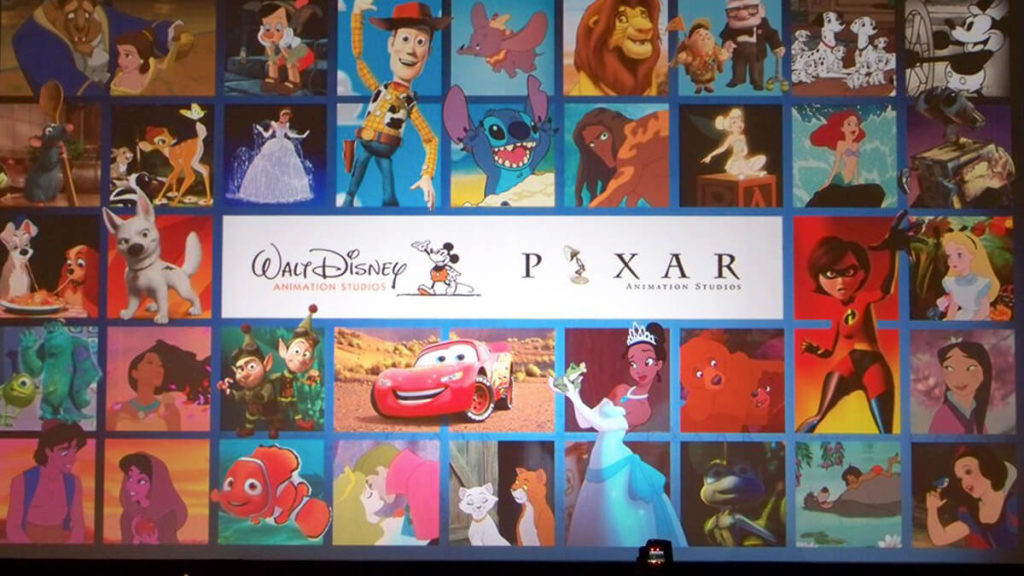
But then — in January of 2006 — The Walt Disney Company announced that it would be acquiring Pixar Animation Studios for $7.4 billion . And word came down from on high to WDI that Bob Iger (i.e., the newly installed head of The Walt Disney Company. Bob had been the Big Cheese at the Mouse for only four months at this point. Anyway … )
Word came down from on high that Bob really, really , REALLYwanted to see some Pixar-themed attractions get put in the pipeline for the Parks.
And here are Rafferty & Coltrin still trying to put a square peg (Mickey & friends) in a round hole (have these classic Disney characters host a ride-thru shooting gallery attraction in which they’re now supposedly working at a carnival in the midway games section). And Kevin & Robert pause for a moment and think “Well, would this ride concept work better with some Pixar characters instead of Mickey & friends?”
More Toy Story Characters – Green-lighting Toy Story Midway Mania
I mean, they couldn’t use the “Toy Story” characters … Could they? After all, “Buzz Lightyear Astro Blaster” had just opened up eight months earlier over at Disneyland Park. And Buzz was one of the lead characters from “Toy Story.” WDI management would never allow them to create yet another ride-thru shooting gallery based on the exact same IP … Would they?
Rafferty said that — in the 30 years that he had worked at WDI — he had never seen a ride concept move so quickly through the approval process. Just six weeks after they drew up some concept art for this proposed attraction (which was now known as “Toy Story Midway Mania”) and then wrote their pitch. Which was this:
“Traditional midway games that you can ride through, hosted by the Toy Story characters.”
Building Toy Story Midway Mania at Disneyland and Walt Disney World

This project was not only greenlit, but Disney management wanted two versions of this attraction built. One for Disney California Adventure Park and another for Disney’s Hollywood Studios.
Now keep in mind that — again — Disney bought Pixar in January of 2006. Rafferty & Coltrin began pitching their “Toy Story Midway Mania” concept in the Spring of that same year. And by the Summer of 2006, this project — which called for the construction of two $80 million attractions on opposite sides of the continent — was a “Go.”
Which is why — on August 19 th of that year — the East Coast version of “Who Wants to Be a Millionaire — Play It!” suddenly closed. So that all of the sets & seats for this recreation of ABC’s once-hugely-popular game show could then be cleared out of Soundstage 3.
On the West Coast … Well, the Imagineers originally toyed with the idea of pulling down the Mailboomer and then building the show building for DCA’s version of “Toy Story Midway Mania!” there. But it was quickly determined that that site had too small a footprint for the ride-thru shooting gallery ride that WDI now wanted to build at that theme park.
Which is when Robert Coltrin proposed a unique solution: What if the Imagineers were to build the show building for the West Coast version of “Toy Story Midway Mania!” under that theme park’s California Screamin’ roller coaster? After some onsite survey work was done, it was determined that — yeah — Robert’s idea would work. All they’d need to do is remove three of the booths for Paradise Pier’s carnival midway games and one steel support beam for California Screamin.
This project was officially announced at a press conference which was held at Walt Disney World on December 15, 2006 . Barely 11 months after Disney bought Pixar.
Differences Between Toy Story Midway Mania in Walt Disney World and Disneyland
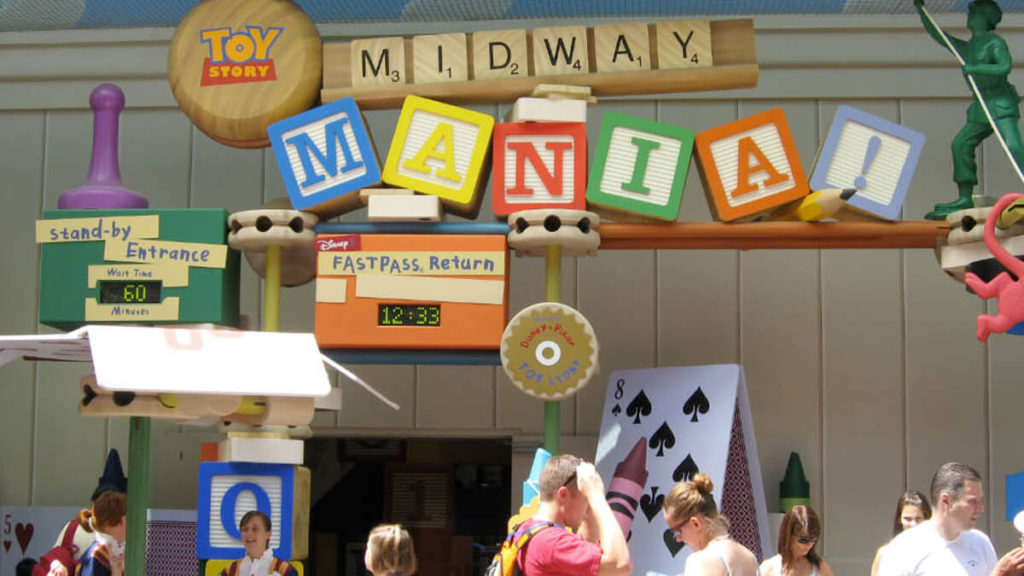
Want to stress here that — while the interiors of these two ride-thru shooting gallery attraction were basically supposed to be identical — the exteriors of the West Coast & East Coast versions of the “Toy Story Midway Mania” show buildings were two very different animals.
The DCA version had to fit in with Paradise Pier’s pre-established design esthetic (i.e., which was “a tribute to Southern California’s amusement piers of the 1920s & 1930s ). So that show building was deliberately designed to look like a turn-of-the-century seaside structure that would then fit right in with this area’s carnival-like atmosphere.
Whereas the Disney’s Hollywood Studios version of “Toy Story Midway Mania” … Well, since this theme park celebrated movie making, John Lasseter got the idea that the East Coast version of this ride-thru shooting gallery should be located in an entirely new “land” at that theme park: Pixar Place. Which would then ape the look of the actual Pixar Animation Studio campus in Emeryville, CA. Right down to the color of the bricks that would be used to decorate the exterior walls of Soundstage 3.
Toy Story Midway Mania Character CG Animation and Guest Shrinking
While work was already well underway on these two huge show buildings, WDI was working with the folks at Pixar on the CG version of the Pixar characters that would appear inside of this attraction. Believe it or not, this was the very first time that Woody, Buzz, Bo & Jessie had ever been done in 3D animation. So there was a lot of trial & error involved here when it came to get the look of these Pixar characters just right.
One particular concern was making sure that the cast of “Toy Story” didn’t get too big. Remember, the creative conceit of this ride-thru shooting gallery attraction is that we’ve been shrunk down to the size of toys. And we’ve now been invited under Andy’s bed, which is where Hamm, Rex and the Little Green Space Aliens have set up a variety of carnival games.
During the playtesting phase of this attraction at WDI headquarters in Glendale, CA, the Imagineers played very close to how people reacted to the full-sized animated versions of Buzz, Woody, Bo & Jessie. They found that — if they made these “Toy Story” characters any taller than 5 foot, six — they then got kind of scary.
Mr. Potato Head Audio Animatronic in Toy Story Midway Mania

That’s why the Audio Animatronic version of Mr. Potato Head (who plays the carnival barker for this ride-thru shooting gallery. He’s outside for the DCA version and inside for the Florida version) is only 5 feet tall . But to make sure that the folks in the back of the queue can see him, Mr. Potato Head is positioned on top of a three foot tall pedestal.
The Imagineers really wanted this AA figure to be able to interact with the Guests as they moved through the “Toy Story Midway Mania” queue. Which is why they had Don Rickles come to WDI headquarters and record upwards of 30 – 35 hours worth of dialogue.
Don was in his early 80s at the time. But Kevin Rafferty and Roger Gould (he’s Pixar’s creative liaison to WDI) have very fond memories of those long, long hours in the booth with Rickles. He recorded every bit of dialogue without complaint. Only occasionally (largely because this is what people expected of Don when they met him) would he put on his insult comic hat. Gould recalls that Don once told him that he was “ … like the son I never wanted.”
Don Rickles: Voice of Mr. Potato Head

Don Rickles actually got to be the voice of Mr. Potato Head in the “Toy Story” movies. In the early 1990s, John Lasseter personally drove out to Malibu to try & pitch Rickles on this role. He even bought a plastic Mr. Potato Head doll as a gift for Don.
Anyway … Lasseter walks to the front door of the Rickles’ Point Dume home. Don personally answers the door after John rings. Lasseter goes to hand Rickles the Mr. Potato Head doll. And — of course — its little plastic hat falls off, as they always do. Don bends over to pick up that hat. And as he does, Lasseter looks down and realizes that Rickle’s head looks exactly like a potato. It’s the perfect potato shape. So it’s fate that Don was up for this part.
I don’t think Lasseter told Rickles that his head was potato-shaped until after he actually signed his “Toy Story” contract.
Sadly, we lost Rickles in April of 2017 at the age of 90 .
Which — given that “Toy Story 4” didn’t arrive in theaters ‘til two years & two months later (June 21, 2019 to be exact) should have meant that we wouldn’t hear Don voicing Mr. Potato Head in that Pixar Animation film. But because WDI had all 30 – 35 hours worth of recordings that that Rickles did for the carnival barker version of Mr. Potato Head that appears in “Toy Story Midway Mania,” the sound team at Pixar was able to repurpose some of that dialogue. Which is why the Mr. Potato Head that you hear in “Toy Story 4” is the real deal. Authentic Don Rickles.
Mind you, it took hours & hours & hours of work to do this. But — in the end — it was a worthy tribute to a comedy legend.
How Much Did It Cost to Build Toy Story Midway Mania
Bob Iger was so pleased with the work that was being done on the “Toy Story Midway Mania” project (which — again — cost $80 million each to build. The full cost of both the East Coast & the West Coast versions of this ride-thru shooting gallery attraction — if you include the exterior work & area improvements — reportedly came in just north of $200 million )
By the Summer of 2007, Bob Iger was so pleased with the way the “Toy Story Midway Mania” project was shaping up that he then decided to roll the dice on DCA. Which is why — on October 17 th of that same year — Iger announced that Disneyland’s second gate would soon undergo a 5-year-long, $1.1 billion makeover. With the first component of this DCA redo being … You guessed it. “Toy Story Midway Mania!”
When did Toy Story Midway Mania Open?
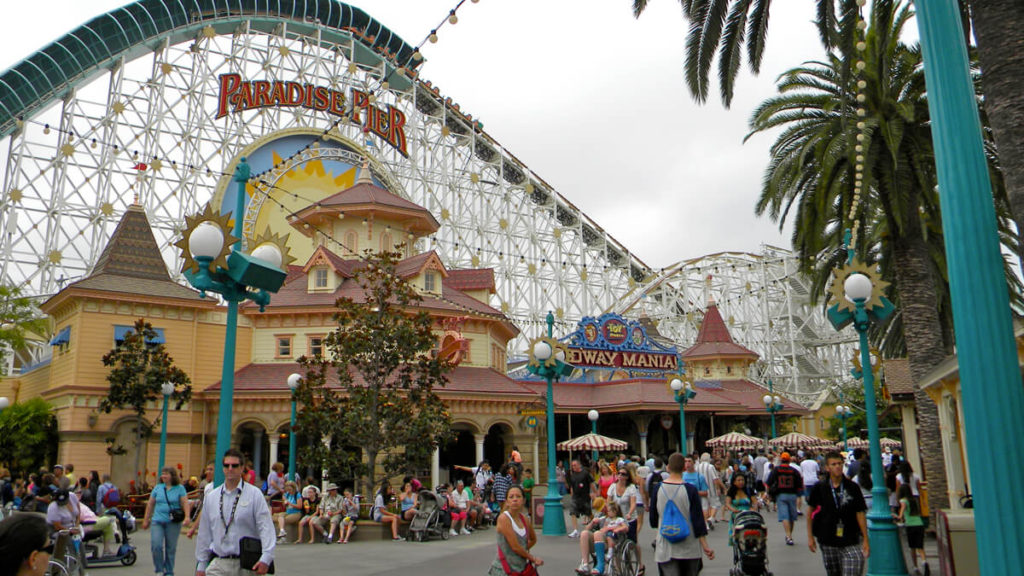
The Disney’s Hollywood Studios version of “Toy Story Midway Mania” opened on May 31, 2008 .
The California Adventure version of “Toy Story Midway Mania” opened some three weeks later on June 17 th of that same year.
These ride-thru shooting galleries were such a huge hit that the Oriental Land Company reached out and insisted that they get one for the Tokyo Disney Resort as well. That one opened at Tokyo DisneySea some four years later. On July 9, 2012 to be exact.
Disney-MGM Rebranding Tied to Toy Story Midway Mania
Disney World’s third theme park was known as Disney-MGM until January 6, 2008 . The very next day, this theme park was renamed / rebranded as Disney’s Hollywood Studios. And a big part of that theme park’s renaming / rebranding effort was tied to “Toy Story Midway Mania.” Cast Members at the WDW Resort were actively coached to say — when Guests asked:
Q:Where is that new Toy Story ride? Which park do I have to go to? The Magic Kingdom? Epcot? MGM?
A:No. You want to go to Disney’s Hollywood Studios.
Buzz Lightyear wasn’t there in person for the opening of the Disney’s Hollywood Studios version of “Toy Story Midway Mania.” That’s because — that morning ( May 31, 2008 ) — an action figure version of this “Toy Story” character had been launched into space aboard the Space Shuttle . Kind of cool publicity stunt.
Expanding Toy Story Midway Mania

Now remember how we’d just been talking about how Walt — in the late 1950s — in response to the popularity of the Tomorrowland Autopia built two more Autopias inside of Disneyland Park.
Well, the Walt Disney World version of “Toy Story Midway Mania” started off hugely popular and then just got busier from there. And then — in hindsight — the combination of all that brick & the hot Florida sun may have been a mistake. Especially given the number of people who’d queue up outside in that very tight space inside of Pixar Place and then stand in the sun for hours, waiting to get into the interior air conditioning queue space for “Toy Story Midway Mania.”
After one too many tourist face-planted on those bricks, the Imagineers decided that it was finally time to do something about the Florida version of “Toy Story Midway Mania.” Which is why — on March 5, 2015 — they announced that they’d not only be adding a third ride track to the Florida version of this ride-thru shooting gallery attraction but that they’d soon be adding a third theater to Epcot’s “Soarin’ “ attraction.
Some 14 months later , the third track for the Disney’s Hollywood Studios version of “Toy Story Midway Mania” opens in May of 2016 . And then — just a week or so after that — the third theater for “Soarin’ “ opens over in Epcot’s Future World section on May 27 th of that same year .

History
The Evolution and History of Mickey’s ToonTown

Disneyland in Anaheim, California, holds a special place in the hearts of Disney fans worldwide, I mean heck, it’s where the magic began after all. Over the years it’s become a place that people visit in search of memorable experiences. One fan favorite area of the park is Mickey’s Toontown, a unique land that lets guests step right into the colorful, “Toony” world of Disney animation. With the recent reimagining of the land and the introduction of Micky and Minnies Runaway Railway, have you ever wondered how this land came to be?
There is a fascinating backstory of how Mickey’s Toontown came into existence. It’s a tale of strategic vision, the influence of Disney executives, and a commitment to meeting the needs of Disney’s valued guests.
The Beginning: Mickey’s Birthdayland
The story of Mickey’s Toontown starts with Mickey’s Birthdayland at Walt Disney World’s Magic Kingdom. Opened in 1988 to celebrate Mickey Mouse’s 60th birthday, this temporary attraction was met with such overwhelming popularity that it inspired Disney executives to think bigger. The idea was to create a permanent, immersive land where guests could step into the animated world of Mickey Mouse and his friends.
In the early ’90s, Disneyland was in need of a refresh. Michael Eisner, the visionary leader of The Walt Disney Company at the time, had an audacious idea: create a brand-new land in Disneyland that would celebrate Disney characters in a whole new way. This was the birth of Mickey’s Toontown.
Initially, Disney’s creative minds toyed with various concepts, including the idea of crafting a 100-Acre Woods or a land inspired by the Muppets. However, the turning point came when they considered the success of “Who Framed Roger Rabbit.” This film’s popularity and the desire to capitalize on contemporary trends set the stage for Toontown’s creation.
From Concept to Reality: The Birth of Toontown
In 1993, Mickey’s Toontown opened its gates at Disneyland, marking the first time in Disney Park history where guests could experience a fully realized, three-dimensional world of animation. This new land was not just a collection of attractions but a living, breathing community where Disney characters “lived,” worked, and played.
Building Challenges: Innovative Solutions
The design of Mickey’s Toontown broke new ground in theme park aesthetics. Imagineers were tasked with bringing the two-dimensional world of cartoons into a three-dimensional space. This led to the creation of over 2000 custom-built props and structures that embodied the ‘squash and stretch’ principle of animation, giving Toontown its distinctiveness.
And then there was also the challenge of hiding the Team Disney Anaheim building, which bore a striking resemblance to a giant hotdog. The Imagineers had to think creatively, using balloon tests and imaginative landscaping to seamlessly integrate Toontown into the larger park.

Key Attractions: Bringing Animation to Life
Mickey’s Toontown featured several groundbreaking attractions. “Roger Rabbit’s Car Toon Spin,” inspired by the movie “Who Framed Roger Rabbit,” became a staple of Toontown, offering an innovative ride experience. Gadget’s Go-Coaster, though initially conceived as a Rescue Rangers-themed ride, became a hit with younger visitors, proving that innovative design could create memorable experiences for all ages.
Another crown jewel of Toontown is Mickey’s House, a walkthrough attraction that allowed guests to explore the home of Mickey Mouse himself. This attraction was more than just a house; it was a carefully crafted piece of Disney lore. The house was designed in the American Craftsman style, reflecting the era when Mickey would have theoretically purchased his first home in Hollywood. The attention to detail was meticulous, with over 2000 hand-crafted, custom-built props, ensuring that every corner of the house was brimming with character and charm. Interestingly, the design of Mickey’s House was inspired by a real home in Wichita Falls, making it a unique blend of real-world inspiration and Disney magic.
Mickey’s House also showcased Disney’s commitment to creating interactive and engaging experiences. Guests could make themselves at home, sitting in Mickey’s chair, listening to the radio, and exploring the many mementos and references to Mickey’s animated adventures throughout the years. This approach to attraction design – where storytelling and interactivity merged seamlessly – was a defining characteristic of ToonTown’s success.

Executive Decisions: Shaping ToonTown’s Unique Attractions
The development of Mickey’s Toontown wasn’t just about creative imagination; it was significantly influenced by strategic decisions from Disney executives. One notable input came from Jeffrey Katzenberg, who suggested incorporating a Rescue Rangers-themed ride. This idea was a reflection of the broader Disney strategy to integrate popular contemporary characters and themes into the park, ensuring that the attractions remained relevant and engaging for visitors.
In addition to Katzenberg’s influence, Frank Wells, the then-President of The Walt Disney Company, played a key role in the strategic launch of Toontown’s attractions. His decision to delay the opening of “Roger Rabbit’s Car Toon Spin” until a year after Toontown’s debut was a calculated move. It was designed to maintain public interest in the park by offering new experiences over time, thereby giving guests more reasons to return to Disneyland.
These executive decisions highlight the careful planning and foresight that went into making Toontown a dynamic and continuously appealing part of Disneyland. By integrating current trends and strategically planning the rollout of attractions, Disney executives ensured that Toontown would not only capture the hearts of visitors upon its opening but would continue to draw them back for new experiences in the years to follow.
Global Influence: Toontown’s Worldwide Appeal
The concept of Mickey’s Toontown resonated so strongly that it was replicated at Tokyo Disneyland and influenced elements in Disneyland Paris and Hong Kong Disneyland. Each park’s version of Toontown maintained the core essence of the original while adapting to its cultural and logistical environment.
Evolution and Reimagining: Toontown Today
As we approach the present day, Mickey’s Toontown has recently undergone a significant reimagining to welcome “Mickey & Minnie’s Runaway Railway” in 2023. This refurbishment aimed to enhance the land’s interactivity and appeal to a new generation of Disney fans, all while retaining the charm that has made ToonTown a beloved destination for nearly three decades.

Dive Deeper into ToonTown’s Story
Want to know more about Mickey’s Toontown and hear some fascinating behind-the-scenes stories, then check out the latest episode of Disney Unpacked on Patreon @JimHillMedia. In this episode, the main Imagineer who worked on the Toontown project shares lots of interesting stories and details that you can’t find anywhere else. It’s full of great information and fun facts, so be sure to give it a listen!
History
Unpacking the History of the Pixar Place Hotel

Pixar Place Hotel, the newly unveiled 15-story tower at the Disneyland Resort, has been making waves in the Disney community. With its unique Pixar-themed design, it promises to be a favorite among visitors.
However, before we delve into this exciting addition to the Disneyland Resort, let’s take a look at the fascinating history of this remarkable hotel.
The Emergence of the Disneyland Hotel
To truly appreciate the story of the Pixar Place Hotel, we must turn back the clock to the early days of Disneyland. While Walt Disney had the visionary ideas and funding to create the iconic theme park, he faced a challenge when it came to providing accommodations for the park’s visitors. This is where his friend Jack Wrather enters the picture.
Jack Wrather, a fellow pioneer in the television industry, stepped in to assist Walt Disney in realizing his dream. Thanks to the success of the “Lassie” TV show produced by Wrather’s company, he had the financial means to build a hotel right across from Disneyland.
The result was the Disneyland Hotel, which opened its doors in October 1955. Interestingly, the early incarnation of this hotel had more of a motel feel than a hotel, with two-story buildings reminiscent of the roadside motels popular during the 1950s. The initial Disneyland Hotel consisted of modest structures that catered to visitors looking for affordable lodging close to the park. While the rooms were basic, it marked the beginning of something extraordinary.
The Evolution: From Emerald of Anaheim to Paradise Pier
As Disneyland’s popularity continued to soar, so did the demand for expansion and improved accommodations. In 1962, the addition of an 11-story tower transformed the Disneyland Hotel, marking a significant transition from a motel to a full-fledged hotel.
The addition of the 11-story tower elevated the Disneyland Hotel into a more prominent presence on the Anaheim skyline. At the time, it was the tallest structure in all of Orange County. The hotel’s prime location across from Disneyland made it an ideal choice for visitors. With the introduction of the monorail linking the park and the hotel, accessibility became even more convenient. Unique features like the Japanese-themed reflecting pools added to the hotel’s charm, reflecting a cultural influence that extended beyond Disney’s borders.
Japanese Tourism and Its Impact
During the 1960s and 1970s, Disneyland was attracting visitors from all corners of the world, including Japan. A significant number of Japanese tourists flocked to Anaheim to experience Walt Disney’s creation. To cater to this growing market, it wasn’t just the Disneyland Hotel that aimed to capture the attention of Japanese tourists. The Japanese Village in Buena Park, inspired by a similar attraction in Nara, Japan, was another significant spot.
These attractions sought to provide a taste of Japanese culture and hospitality, showcasing elements like tea ceremonies and beautiful ponds with rare carp and black swans. However, the Japanese Village closed its doors in 1975, likely due to the highly competitive nature of the Southern California tourist market.
The Emergence of the Emerald of Anaheim
With the surge in Japanese tourism, an opportunity arose—the construction of the Emerald of Anaheim, later known as the Disneyland Pacific Hotel. In May 1984, this 15-story hotel opened its doors.
What made the Emerald unique was its ownership. It was built not by The Walt Disney Company or the Oriental Land Company (which operated Tokyo Disneyland) but by the Tokyu Group. This group of Japanese businessmen already had a pair of hotels in Hawaii and saw potential in Anaheim’s proximity to Disneyland. Thus, they decided to embark on this new venture, specifically designed to cater to Japanese tourists looking to experience Southern California.
Financial Challenges and a Changing Landscape
The late 1980s brought about two significant financial crises in Japan—the crash of the NIKKEI stock market and the collapse of the Japanese real estate market. These crises had far-reaching effects, causing Japanese tourists to postpone or cancel their trips to the United States. As a result, reservations at the Emerald of Anaheim dwindled.
To adapt to these challenging times, the Tokyu Group merged the Emerald brand with its Pacific hotel chain, attempting to weather the storm. However, the financial turmoil took its toll on the Emerald, and changes were imminent.
The Transition to the Disneyland Pacific Hotel
In 1995, The Walt Disney Company took a significant step by purchasing the hotel formerly known as the Emerald of Anaheim for $35 million. This acquisition marked a change in the hotel’s fortunes. With Disney now in control, the hotel underwent a name change, becoming the Disneyland Pacific Hotel.
Transformation to Paradise Pier
The next phase of transformation occurred when Disney decided to rebrand the hotel as Paradise Pier Hotel. This decision aligned with Disney’s broader vision for the Disneyland Resort.
While the structural changes were limited, the hotel underwent a significant cosmetic makeover. Its exterior was painted to complement the color scheme of Paradise Pier, and wave-shaped crenellations adorned the rooftop, creating an illusion of seaside charm. This transformation was Disney’s attempt to seamlessly integrate the hotel into the Paradise Pier theme of Disney’s California Adventure Park.
Looking Beyond Paradise Pier: The Shift to Pixar Place
In 2018, Disneyland Resort rebranded Paradise Pier as Pixar Pier, a thematic area dedicated to celebrating the beloved characters and stories from Pixar Animation Studios. As a part of this transition, it became evident that the hotel formally known as the Disneyland Pacific Hotel could no longer maintain its Paradise Pier theme.
With Pixar Pier in full swing and two successful Pixar-themed hotels (Toy Story Hotels in Shanghai Disneyland and Tokyo Disneyland), Disney decided to embark on a new venture—a hotel that would celebrate the vast world of Pixar. The result is Pixar Place Hotel, a 15-story tower that embraces the characters and stories from multiple Pixar movies and shorts. This fully Pixar-themed hotel is a first of its kind in the United States.
The Future of Pixar Place and Disneyland Resort
As we look ahead to the future, the Disneyland Resort continues to evolve. The recent news of a proposed $1.9 billion expansion as part of the Disneyland Forward project indicates that the area surrounding Pixar Place is expected to see further changes. Disneyland’s rich history and innovative spirit continue to shape its destiny.
In conclusion, the history of the Pixar Place Hotel is a testament to the ever-changing landscape of Disneyland Resort. From its humble beginnings as the Disneyland Hotel to its transformation into the fully Pixar-themed Pixar Place Hotel, this establishment has undergone several iterations. As Disneyland Resort continues to grow and adapt, we can only imagine what exciting developments lie ahead for this iconic destination.
If you want to hear more stories about the History of the Pixar Place hotel, check our special edition of Disney Unpacked over on YouTube.
Stay tuned for more updates and developments as we continue to explore the fascinating world of Disney, one story at a time.
History
From Birthday Wishes to Toontown Dreams: How Toontown Came to Be

In the latest release of Episode 4 of Disney Unpacked, Len and I return, joined as always by Disney Imagineering legend, Jim Shull . This two-part episode covers all things Mickey’s Birthday Land and how it ultimately led to the inspiration behind Disneyland’s fan-favorite land, “Toontown”. But let’s not get ahead of ourselves here. It all starts in the early days at Disneyland.
Early Challenges in Meeting Mickey
Picture this: it’s the late 1970s and early 1980s, and you’re at Disneyland. You want to meet the one and only Mickey Mouse, but there’s no clear way to make it happen. You rely on Character Guides, those daily printed sheets that point you in Mickey’s general direction. But let’s be honest, it was like finding a needle in a haystack. Sometimes, you got lucky; other times, not so much.

Mickey’s Birthdayland: A Birthday Wish that Came True
Fast forward to the late 1980s. Disney World faced a big challenge. The Disney-MGM Studios Theme Park was under construction, with the company’s marketing machine in full swing, hyping up the opening of Walt Disney World’s third theme park, MGM Studios, in the Spring of 1989. This extensive marketing meant that many people were opting to postpone their family’s next trip to Walt Disney World until the following year. Walt Disney World needed something compelling to motivate guests to visit Florida in 1988, the year before Disney MGM Studios opened.
Enter stage left, Mickey’s Birthdayland. For the first time ever, an entire land was dedicated to a single character – and not just any character, but the mouse who started it all. Meeting Mickey was no longer a game of chance; it was practically guaranteed.

The Birth of Birthdayland: Creative Brilliance Meets Practicality
In this episode, we dissect the birth of Mickey’s Birthdayland, an initiative that went beyond celebrating a birthday. It was a calculated move, driven by guest feedback and a need to address issues dating back to 1971. Imagineers faced the monumental task of designing an experience that honored Mickey while efficiently managing the crowds. This required the perfect blend of creative flair and logistical prowess – a hallmark of Disney’s approach to theme park design.
Evolution: From Birthdayland to Toontown
The success of Mickey’s Birthdayland was a real game-changer, setting the stage for the birth of Toontown – an entire land that elevated character-centric areas to monumental new heights. Toontown wasn’t merely a spot to meet characters; it was an immersive experience that brought Disney animation to life. In the episode, we explore its innovative designs, playful architecture, and how every nook and cranny tells a story.

Impact on Disney Parks and Guests
Mickey’s Birthdayland and Toontown didn’t just reshape the physical landscape of Disney parks; they transformed the very essence of the guest experience. These lands introduced groundbreaking ways for visitors to connect with their beloved characters, making their Disney vacations even more unforgettable.
Beyond Attractions: A Cultural Influence
But the influence of these lands goes beyond mere attractions. Our episode delves into how Mickey’s Birthdayland and Toontown left an indelible mark on Disney’s culture, reflecting the company’s relentless dedication to innovation and guest satisfaction. It’s a journey into how a single idea can grow into a cherished cornerstone of the Disney Park experience.

Unwrapping the Full Story of Mickey’s Birthdayland
Our two-part episode of Disney Unpacked is available for your viewing pleasure on our Patreon page. And for those seeking a quicker Disney fix, we’ve got a condensed version waiting for you on our YouTube channel . Thank you for being a part of our Disney Unpacked community. Stay tuned for more episodes as we continue to “Unpack” the fascinating world of Disney, one story at a time.

























